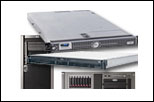Round-up: Dual-core servers

Dual-core processors deliver many benefits, including much-improved performance per watt, over single-core designs. We examine three servers from the leading vendors to see what this technology can do for your business.

A less publicised, but equally important, benefit of multi-core technology is the reduced amount of electricity that processors need, with vendors vying to deliver the best performance-per-watt ratio. That, in turn means lower operating costs -- not to mention helping to save the planet. These benefits are further amplified by simply being able to do more with less. For example, just by upgrading to dual-core you could halve your current number of servers, and still do the same amount of work -- if not more.
In addition to new processors, a lot more has been happening in the server market in terms of storage, networking and manageability, making it very difficult to test and compare like for like. All the more so given that servers come in a range of shapes and sizes -- from free-standing towers, through rack-mount devices to highly space-efficient blade servers.
The aim of this group test, therefore, is to not try and attempt a direct comparison, but to provide a snapshot of the breadth of the most popular industry-standard dual-core servers currently available. More specifically, we've gathered together three two-way dual-core servers designed to be used by enterprises for general file sharing, as front-end Web servers and more specialised hosting duties.
We've chosen one specific model each from market leaders Dell, HP and IBM, although it's worth pointing out that the configurations are far from unique and you'll find similar products from all three vendors, and others too. All support both Intel and AMD processors and all offer a range of freestanding, rack-mount and blade implementations.
Bear that in mind, and hopefully this round-up will provide a good insight as to what's currently available and will help you investigate further the benefits that dual core and, in due course, quad core can provide to your business.
With computing power to burn, the PowerEdge 1950 is ideal where high performance is required. However, the ramped format does make life more difficult when it comes to database hosting and other backend deployments.
It can handle a wide range of backend business applications, but the Proliant ML370 G5 is over-specified for organisations with more modest requirements.
This is a good choice for compute-intensive applications, but the System x3455's restricted storage and availability options limit its use when it comes to general hosting duties.